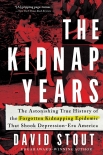The Kidnap Years:, David Stout [readict .txt] 📗

- Author: David Stout
Book online «The Kidnap Years:, David Stout [readict .txt] 📗». Author David Stout
So the image of the FBI badly needed burnishing. If the Union Station slaughter could be pinned on Floyd and if FBI agents could catch him—or, preferably, kill him—then Hoover could claim a major triumph in his war on crime, and the FBI would have avenged the death of one of its own, agent Ray Caffrey.
Floyd made a convenient villain, even a credible one, since he had told Sheriff Killingsworth that he and his pal Richetti were on their way to Kansas City. Soon, another man was being mentioned as a likely accomplice of Floyd and Richetti: Verne Miller, the former sheriff from Huron, South Dakota, who had abandoned his law enforcement career to become a bank robber, bootlegger, and gunman.
But a different theory about the train station episode has persisted, and it is too plausible to be dismissed.* In this version, the Hot Springs gambling kingpin Dick Galatas contacted Kansas City crime boss John Lazia on Friday evening to tell him that Nash had been arrested. (“Brother John” Lazia, it will be remembered, was head of the muscle department for the Tom Pendergast political machine and had been instrumental in securing the release of the kidnapped millionaire dressmaker Nell Donnelly in December 1931.)
After hearing from Galatas, Lazia supposedly tapped into his extensive police sources and learned that a train carrying Nash was to arrive at Union Station on Saturday morning. On Friday night, Lazia is said to have met in a restaurant with Miller to discuss what to do.
Lazia apparently conscripted two of his most efficient gunmen, the brothers Homer and Maurice Denning, to help Miller on a mission—not to free Nash but to kill him so he couldn’t tell what he knew about organized crime in Hot Springs or Kansas City or both.
The possibility that Miller was joined in the ambush by the Brothers Denning rather than Floyd and Richetti was given credence by a witness to the shooting, a gangster named James Henry “Blackie” Audett, who knew Floyd and Richetti by sight and who happened to be in the station parking lot that Saturday morning.
Years later, having left his life of crime, Audett recalled watching the train station bloodbath from less than fifty yards away and clearly seeing the killers. He insisted that they included the Dennings but not Floyd nor Richetti.
But why would the FBI insist that Floyd and Richetti were there? “The FBI had to solve the case fast because one of their own men got killed,” Audett said, “so they pinned it on two guys who were already wanted and widely known.”
There is another aspect of the Union Station Massacre that must be told. Early news accounts reported what seemed self-evident, namely that Nash and the four lawmen were slain by the ambushers armed with machine guns. Indeed, Grooms and Reed were both hit with machine-gun bullets, as was Lackey.
But the back of Nash’s head was blown away, a massive wound characteristic of a shotgun blast from behind at point-blank range. Caffrey and Hermanson also suffered huge head wounds consistent with a shotgun fired at close range. The windshield glass of the car in which Nash was sitting was blown apart and out onto the hood, again suggesting a shotgun blast—from behind.
How to explain all this? The two lawmen who were carrying shotguns were the Oklahoma police chief, Otto Reed, and FBI agent Joe Lackey. Reed was known to be intimately familiar with shotguns. His favorite was a piece that he fitted with a short barrel for law enforcement and a longer barrel for small-game hunting. He even made his own ammunition for police work, cutting open the ends of shotgun shells, removing the standard pellets meant for birds and small game, and inserting ball bearings—the better to bring down human prey.
By contrast, Lackey seems to have been inept with shotguns. In a memo to Hoover after the shooting, he claimed that he had just borrowed a shotgun that morning from the Oklahoma City police department, that the weapon had “jammed” during the shootout, and that he couldn’t get it to function at all.
But it seems far more likely that he was so unfamiliar with the weapon that he didn’t know how to get it ready to fire, because as the lawmen and their prisoner were about to get off the train, Lackey mistakenly picked up Reed’s personal shotgun, which functioned differently from the gun Lackey had borrowed. (Presumably, Reed quickly realized that Lackey had taken his weapon by mistake. So Reed carried the weapon that Lackey had borrowed.)
Most tellingly, ball bearings of the kind that Reed used in his custom-made ammunition were found at the massacre scene. But it seems unlikely that Reed took his own shotgun from Lackey in the car and then fired it. It seems much more likely that Lackey panicked, fumbled with Reed’s gun, and when he finally did manage to pull the trigger with effect, fired wildly, first accidentally killing Nash, who was sitting in front of him, then Caffrey and Hermanson. (Apparently, Reed was killed before he could fire at all.)
For his 2005 book The Union Station Massacre: The Original Sin of J. Edgar Hoover’s FBI, the Pulitzer Prize–winning journalist Robert Unger analyzed the ballistics evidence, the accounts of bystanders—one of whom saw Lackey fumbling with a shotgun—and the contradictory statements that Lackey gave.
Most significantly, Lackey changed his account of where he was sitting. Referring to himself in the third person in his initial memo to Hoover, he wrote, “Agent got in the backseat on the left-hand side [emphasis added].”65 In another early internal memo, again in the third person, Lackey reinforced his recollection: “The agent was crouched down back of the driver’s





Comments (0)